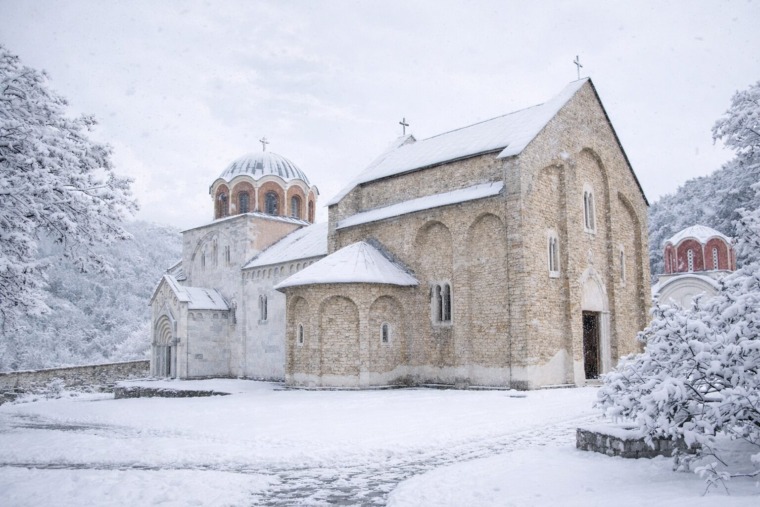

The Miroslav Gospel, the oldest written monument in the Cyrillic script famous for its miniatures in gold, is today a part of world heritage.
After the fall of Jerusalem in the hands of the mighty Saladin, the Third crusade was started in the end of the 12th century. At the same time, the writing of a gospel book for the church of St. Peter in the city of Bijelo Polje was ordered by duke Miroslav of Hum, the older brother of Stefan Nemanja, Grand Prince of Rascia and founder of the Nemanjić ruling family. Till this day, this “Miroslav gospel“, a gospel book in which the gospels are arranged according to the readings during the year, has remained the oldest preserved manuscript in the Cyrillic script.
Rich decorations with initials and miniatures in different colors and gold, and the fact that it was written in Cyrillic script on white parchment, a rarity at the time, only attributed to its status of the unique masterpiece of world heritage. UNESCO has recognized the importance of this historical and artistic monument and included it in the list of the most significant documents, beside the Archive of Nikola Tesla and documents such as the 1789 French declaration on human rights from, the collection of Schubert’s and Chopin’s works, Goethe’s manuscripts, Beethoven’s Ninth symphony, Gutenberg’s Bible and Nicola Copernicus’s manuscripts.
The Miroslav gospel was taken to the Hilandar monastery at Holy Mountain (Mt. Athos), probably after duke Miroslav’s death but the exact date remained unknown.
It was kept there until 1846 and the visit of Russian archimandrite and later the bishop of Kiev, Porphyrius, who, perhaps stunned with its beauty, cut out a page from the Miroslav gospel and took it to Russia.
This rarity of Serbian and world literature survived a turbulent odyssey. During the retreat through Albania in the World War I, the Serbian army took the Miroslav gospel to the island of Corfu in Greece and it managed to survive till this day. After World War I the gospel was treasured in the newly founded Museum of Prince Pavle Karadjordjević, as it was owned by the royal Karadjordjević dynasty.
At the beginning of the World War II, the Miroslav gospel luckily wasn’t in the National Library in Belgrade which was bombed in 1941 when many treasures of Serbian cultural heritage got destroyed. It was later kept in the Rača monastery and then transferred to the vault of the National Bank in Belgrade just in time to avoid being looted from the monastery.
After the war the Miroslav Gospel was transferred to the National Museum in Belgrade where it has been treasured to date. One page from it is being kept in the National library in Saint Petersburg.
The Miroslav gospel is actually the translation of a Greek gospel book from the Constantinople’s (Istanbul’s) church of St. Sofia, and it was mostly written by an unknown scrivener. The other writer was Gligorije “dijak” (djak), who completed the book in four short inscriptions and decorated the text with ornaments. The Miroslav gospel was written on parchment and decorated with 300 miniatures and initials in gold and color.
The main text was written in two scripts of Serbo-Slavic language – Zeta-Hum and Rascia language. The text was written in two columns and decorated with 296 miniatures, drawn with pen and then colored with brushes in red, yellow, green and white.
The miniatures were then decorated with gold, and the most famous initial is the letter V with the miniature presenting Aleksandar the Great rising in the skies with a magician’s hat. Another famous initial from the Miroslav gospel, the letter P with two birds, later became the symbol of the National Museum in Belgrade.
This unique Gospel Book has one particular curiosity – the miniatures presenting Christ and John the Baptist are painted in a peculiar way, with both of them having six fingers on the right hand.
Related Articles


From Fireworks to Family Dinners: New Year’s Eve Across Serbia
December 31, 2025
Kuršumlijska Banja: Serbia’s Quiet Winter Spa Escape
December 30, 2025
Novak Đokovic Receives Special Globe Soccer Award in Dubai
December 29, 2025





